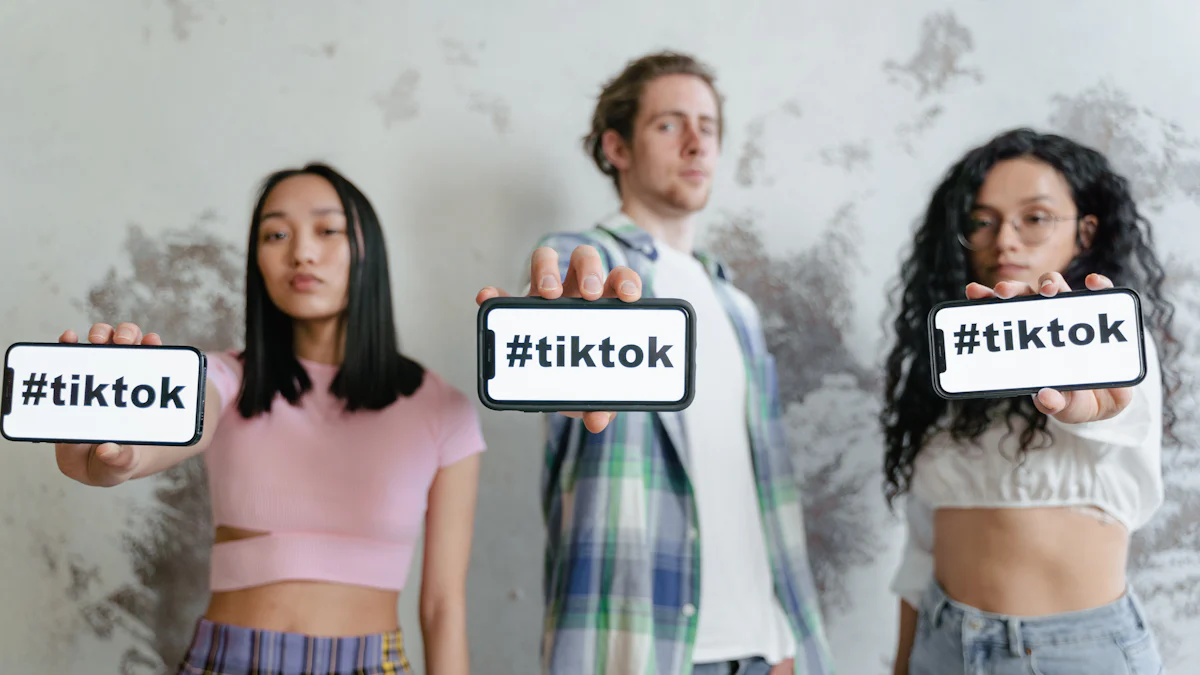Who Earns More on Social Media: Celebrities or Non-Celebrity Influencers

When it comes to social media, celebrities often dominate the spotlight. Their massive reach and established fame make them some of the highest paid social media influencers. But have you ever wondered why brands are increasingly turning to non-celebrity influencers? It’s all about connection. Non-celebrity influencers, like micro-influencers, thrive on authenticity. They interact with their followers, share relatable stories, and build trust. For example, creators like Mercedes Lasac and Miss Ginbilog resonate deeply with their audiences, driving higher engagement and better ROI for brands. This shift in influencer marketing shows how relatability can sometimes outperform fame.
Defining Celebrities and Non-Celebrity Influencers
Who Are Celebrity Influencers?
Characteristics of celebrity influencers
When you think of celebrity influencers, you probably picture actors, musicians, or athletes with millions of followers. These individuals already have fame from their careers, which gives them a massive online presence. Their social media accounts often showcase glamorous lifestyles, exclusive events, and collaborations with luxury brands. Celebrity influencers usually have a global audience, making them ideal for campaigns that need widespread visibility.
One key trait of a celebrity influencer is their ability to instantly grab attention. Their posts often go viral because of their star power. However, their content can sometimes feel less personal since they cater to such a broad audience.
Examples of the highest paid social media influencers
Some of the highest paid celebrity influencers include names like Cristiano Ronaldo, Kylie Jenner, and Dwayne "The Rock" Johnson. Ronaldo, for instance, earns millions per Instagram post, thanks to his unmatched global reach. Kylie Jenner, with her beauty empire, combines her celebrity status with business savvy, making her one of the most influential figures online. These celebrities dominate platforms like Instagram, but their influence extends to TikTok and YouTube as well.
Who Are Non-Celebrity Influencers?
Micro-influencers vs. celebrities: Key differences
Now, let’s talk about non-celebrity influencers, especially micro-influencers. These are everyday people who’ve built a loyal following in specific niches. Unlike celebrities, micro-influencers focus on relatable content. They might share fitness tips, parenting advice, or even DIY projects. Their audience feels like they’re following a friend, not a distant star.
Here’s the big difference: micro-influencers often have higher engagement rates. While celebrities might have millions of followers, their posts don’t always spark interaction. Micro-influencers, on the other hand, create conversations. This is why brands love working with them for targeted campaigns.
Examples of successful non-celebrity influencers
Take someone like Emma Chamberlain. She started as a YouTuber and grew into a microcelebrity with a devoted fanbase. Or consider micro-influencers on TikTok, like Charli D’Amelio, who began with dance videos and now partners with major brands. These influencers prove that you don’t need to be a celebrity to make a big impact.
Comparing Earnings: Celebrities vs Non-Celebrity Influencers

Average Earnings Per Post
Data on celebrity influencer earnings
When it comes to earnings per post, celebrity influencers dominate the charts. Their massive follower counts and global appeal allow them to charge premium rates. For instance, on Instagram, a celebrity influencer can earn anywhere from $10,000 to over $1 million per post. On platforms like Facebook, their earnings range between $12,500 and $25,000 per post. Even on TikTok, where engagement is key, celebrities still command impressive rates. Here's a quick breakdown of average earnings across platforms:
| Influencer Platform | Type of Influencer | Earnings Per Post |
|---|---|---|
| Mega Influencers/Celebrities | $10,000+ to $1 million or more | |
| TikTok | Macro Influencer | $300 – $1,000 |
| YouTube | Mid-tier Influencers | $1,000 – $10,000 |
| Macro Influencers | $12,500 – $25,000 | |
| X (Twitter) | Macro Influencer | $20 – $100 |
These numbers highlight why celebrities are among the highest paid social media influencers. Their reach and star power make them a go-to choice for brands aiming for mass visibility.
Data on non-celebrity influencer earnings
Non-celebrity influencers, including micro-influencers, may not earn as much per post, but they still bring significant value. Micro-influencers with 10,000 to 100,000 followers earn an average of $1,211 per post. Nano influencers, with smaller audiences of 1,000 to 10,000 followers, earn about $195 per post. Here's how their earnings compare:
| Influencer Type | Followers | Average Income Per Post |
|---|---|---|
| Nano Influencers | 1k —10k | $195 |
| Micro Influencers | 10k —100k | $1,211 |
While these figures may seem modest compared to celebrity influencers, the higher engagement rates of micro-influencers often make them a better investment for brands.
Total Annual Earnings
How celebrities leverage multiple income streams
Celebrity influencers don’t just rely on social media posts for income. They often combine their online presence with other ventures like brand endorsements, product launches, and even acting or music careers. For example, Kylie Jenner uses her Instagram to promote her beauty empire, generating millions annually. This ability to diversify income streams makes celebrities some of the highest paid social media influencers overall.
How non-celebrity influencers build consistent income
Non-celebrity influencers focus on building steady income through collaborations with niche brands. They often partner with multiple companies throughout the year, creating a consistent revenue stream. Many micro-influencers also monetize their content through affiliate marketing, sponsored posts, and even selling their own products. This approach allows them to maintain a sustainable income, even without the massive reach of a celebrity.
Case Studies
Example of a high-earning celebrity influencer
Cristiano Ronaldo is a prime example of a high-earning celebrity influencer. With over 500 million Instagram followers, he earns more than $2 million per post. His partnerships with global brands like Nike and Herbalife showcase how celebrities can leverage their fame to secure lucrative deals.
Example of a high-earning non-celebrity influencer
Emma Chamberlain, a former micro-influencer turned internet sensation, has built a thriving career through relatable content. She now collaborates with brands like Louis Vuitton and has her own coffee line. Her journey proves that non-celebrity influencers can achieve financial success by staying authentic and connecting with their audience.
Factors Influencing Earnings

Engagement Rates
Why engagement rates matter more than follower count
When it comes to earnings, engagement rates often outweigh follower count. You might think a massive following guarantees success, but that’s not always true. Brands care about how much your audience interacts with your content. Are they liking, commenting, or sharing your posts? These actions show genuine interest, which is what brands want. For example, an influencer in a niche like finance with a smaller but highly engaged audience can earn more per post than someone with a larger, less active following in a crowded market like fashion.
Here’s why engagement matters:
- Brands look for influencers who spark real conversations.
- High engagement rates mean your followers trust your opinions.
- This trust makes your promotional content more effective.
How micro-influencers often outperform celebrities
Micro-influencers shine when it comes to engagement. Their content feels authentic and relatable, which keeps their audience hooked. They also interact more with their followers, responding to comments and messages. This creates a sense of community. In contrast, celebrities often struggle to connect with their diverse audience. Their followers have varied interests, making it harder to engage everyone effectively.
Audience Size and Reach
The advantage of celebrities' massive reach
Celebrities have one undeniable advantage: their massive reach. With millions of followers, they can spread a message far and wide. If you’re a brand looking for global visibility, a celebrity influencer might be your best bet. Their posts can go viral in minutes, reaching audiences across different countries and cultures.
The niche appeal of non-celebrity influencers
Non-celebrity influencers, especially micro-influencers, excel in niche markets. Their followers are often deeply passionate about specific topics, whether it’s fitness, parenting, or DIY crafts. This focus makes their recommendations more impactful. In fact, research shows that engagement rates on Instagram drop as follower counts rise. Smaller influencers often have more engaged audiences, which is why 30% of consumers are more likely to buy a product recommended by a non-celebrity blogger.
Authenticity and Trust
How non-celebrity influencers build trust with their audience
Trust is the secret weapon of non-celebrity influencers. They share personal stories, interact regularly with followers, and keep their content genuine. This authenticity creates strong connections. Their smaller audience size allows for more meaningful interactions, which boosts engagement. When followers feel like they know you, they’re more likely to trust your recommendations.
The challenge of perceived authenticity for celebrities
For celebrities, maintaining authenticity can be tricky. Their fame often creates a barrier between them and their audience. Followers may question whether a celebrity truly uses the products they promote or if it’s just another paid partnership. This skepticism can make it harder for celebrities to build the same level of trust as non-celebrity influencers.
Brand Partnerships and Campaign Goals
When brands prefer celebrities for mass awareness
If a brand wants to make a big splash and grab everyone’s attention, celebrity endorsement is often the go-to strategy. Celebrities bring instant recognition and can link a brand to desirable qualities like luxury, success, or trendiness. Think about it—when McDonald’s teamed up with Travis Scott for a special meal, sales jumped by 10%. That’s the power of a celebrity partnership.
Brands also use celebrities to connect with younger audiences. Their massive reach ensures that campaigns spread far and wide, making them ideal for global visibility. For example, Aerie worked with Busy Philipps to promote body positivity through their #AerieReal campaign. This collaboration not only boosted engagement but also aligned the brand with a meaningful cause.
Other brands have used celebrities to add a unique flair to their campaigns. MVMT partnered with Sam Kolder to target adventurers, while Lowe’s collaborated with Jenn Im for their 'House of Style' series. These partnerships show how celebrities can elevate a brand’s image and create buzz in the influencer marketing industry.
When brands prefer non-celebrity influencers for targeted campaigns
Non-celebrity influencers shine when brands need to connect with specific audiences. Their smaller, more engaged followings make them perfect for niche campaigns. For instance, a camping gear company might work with an outdoor enthusiast to promote their products. Similarly, a sustainable fashion brand could team up with an eco-friendly lifestyle influencer to highlight their commitment to the environment.
These influencers are also more affordable. Many accept modest payments or even product exchanges, which is great for brands with tight budgets. Plus, they’re open to creative collaborations. They’ll co-create content that feels authentic, which resonates more with their followers.
Non-celebrity influencers also engage directly with their audience. Imagine a micro-influencer in sustainable fashion answering questions about eco-friendly practices. That personal touch builds trust and loyalty, making their recommendations more impactful.
Pros and Cons of Each Type of Influencer
Pros of Celebrity Influencers
Massive audience reach
When you think about celebrity influencers, their biggest strength is their massive audience. With millions of followers across platforms, they can spread a message far and wide in no time. If you’re a brand looking to make a global impact, a celebrity endorsement can be a game-changer. Their posts often go viral, giving your campaign the kind of visibility that’s hard to achieve with smaller influencers.
Instant credibility and recognition
Celebrities bring instant credibility to a brand. Their fame and established reputation make people take notice. When a celebrity promotes a product, it feels like a stamp of approval. This recognition can boost your brand’s image and make it stand out in a crowded market. Think about how influencer marketing campaigns with celebrities like Serena Williams or Ryan Reynolds immediately grab attention.
Cons of Celebrity Influencers
High cost per post
The downside? Celebrity influencers come with a hefty price tag. A single post from a top-tier celebrity can cost hundreds of thousands—or even millions—of dollars. This high cost makes them less accessible for smaller brands or those with limited budgets.
Lower engagement rates
While celebrities have huge followings, their engagement rates often fall short. Their audience is so broad that their posts don’t always resonate with everyone. You might see fewer likes, comments, or shares compared to what micro-influencers achieve. This lower engagement can make influencer marketing with celebrities less effective for certain campaigns.
Pros of Non-Celebrity Influencers
Higher engagement and niche appeal
Non-celebrity influencers, especially micro-influencers, excel at connecting with their audience. Their followers trust them because their content feels personal and relatable. This trust leads to higher engagement rates. If you’re targeting a specific niche, micro-influencers are your best bet. They know their audience inside out and can create content that truly resonates.
Cost-effectiveness for brands
Working with non-celebrity influencers is much more affordable. Many micro-influencers charge a fraction of what celebrities demand. This cost-effectiveness allows you to collaborate with multiple influencers, increasing your reach without breaking the bank. Plus, their authentic approach to influencer marketing often delivers better ROI.
Cons of Non-Celebrity Influencers
Limited reach compared to celebrities
Non-celebrity influencers often struggle with one major drawback: their smaller audience size. While their niche appeal is a strength, it also limits how far their message can travel. If you’re looking to promote a product to millions of people in one go, a micro-influencer might not be the best choice. Their reach is usually confined to a specific group of followers who share similar interests.
Think about it this way: a celebrity like Taylor Swift can post about a new perfume, and millions of people across the globe will see it instantly. A non-celebrity influencer, on the other hand, might only reach a few thousand people. This smaller scale can make it harder for brands to achieve widespread visibility.
For you as a brand or marketer, this means you’ll need to work with multiple non-celebrity influencers to match the reach of just one celebrity. While this can still be cost-effective, it requires more time and effort to manage.
Challenges in scaling their influence
Growing as a non-celebrity influencer isn’t easy. Building a loyal audience takes time, consistency, and a lot of effort. You can’t just rely on one viral post to skyrocket your follower count. Instead, you have to keep creating high-quality, engaging content that resonates with your niche.
Another challenge is breaking out of your niche. If you’re known for fitness tips, for example, it can be tough to branch into other areas like fashion or travel. Your audience might not follow you there, which limits your ability to diversify your content and partnerships.
Non-celebrity influencers also face stiff competition. With so many creators vying for attention, standing out can feel like an uphill battle. You need to constantly innovate and adapt to trends to stay relevant. This can be exhausting and might slow down your growth.
Tip: If you’re a non-celebrity influencer, focus on building strong relationships with your audience. Authenticity and engagement are your biggest assets in overcoming these challenges.
When it comes to social media earnings, celebrities and micro-influencers each bring unique strengths to the table. Celebrities often command the highest pay per post, thanks to their massive reach and instant recognition. However, micro-influencers excel in authenticity and engagement, making them a better choice for brands seeking meaningful connections with their audience.
So, how do you decide which is better? It depends on your goals. If you want global visibility, celebrities can deliver. But if you're after trust and long-term loyalty, micro-influencers are the way to go. Their relatable content fosters deeper engagement and builds lasting relationships with followers.
For aspiring influencers, focusing on authenticity and niche appeal is key. Building trust with your audience not only enhances engagement but also opens doors to long-term partnerships. Remember, success isn’t just about follower count—it’s about the quality of your connection with your audience.
Key Takeaway: Whether you're a brand or an influencer, authenticity and engagement are your most valuable assets. They create trust, drive loyalty, and ensure long-term success in the ever-evolving world of social media.
FAQ
1. Why do celebrities charge so much for a single post?
Celebrities charge high rates because of their massive reach and influence. Their posts can instantly reach millions of people worldwide, making them ideal for global campaigns. Brands pay for this visibility and the association with the celebrity’s image.
2. Can non-celebrity influencers earn as much as celebrities?
It’s rare, but possible! Some non-celebrity influencers, like Emma Chamberlain, have built massive followings and diversified income streams. By staying authentic and consistent, you can grow your earnings over time, even without celebrity status.
3. What’s the best platform for influencers to earn money?
Instagram leads for influencer earnings, especially for sponsored posts. TikTok is great for engagement, while YouTube offers ad revenue and long-term content value. Choose the platform where your audience is most active.
4. How can I increase my engagement rate as an influencer?
Focus on creating relatable, high-quality content. Interact with your followers through comments and messages. Use polls, Q&A sessions, and stories to keep your audience engaged. Consistency and authenticity are key.
5. Do brands prefer celebrities or non-celebrity influencers?
It depends on their goals. Brands choose celebrities for mass awareness and global reach. Non-celebrity influencers are better for niche campaigns and building trust with specific audiences. Both have unique strengths.
Tip: If you’re starting out, focus on building trust and engagement. Brands value authenticity more than follower count.
See Also
Deciding On Influencers Versus Brand Representatives For Marketing
Evaluating Smaller Influencers: Benefits And Drawbacks For ROI
Analyzing The Advantages And Disadvantages Of Influencer Marketing
